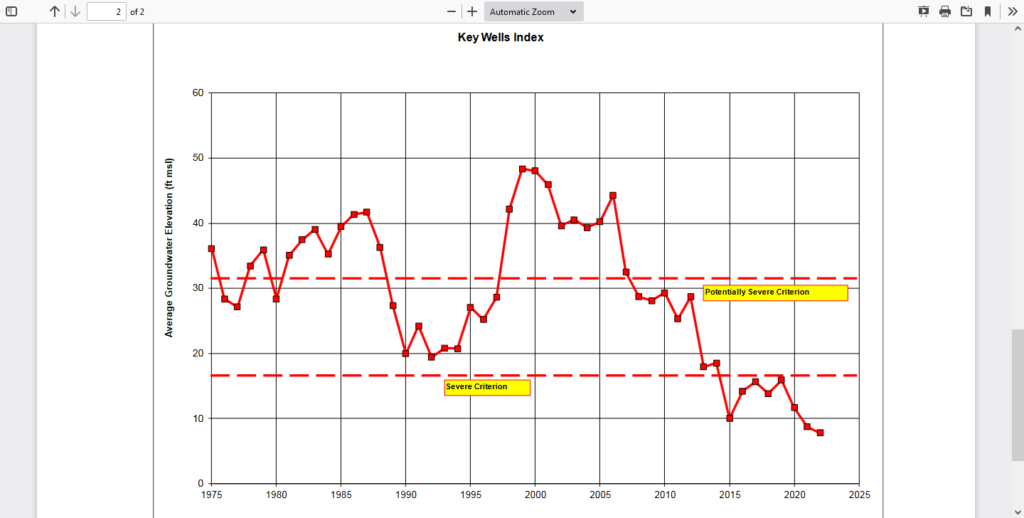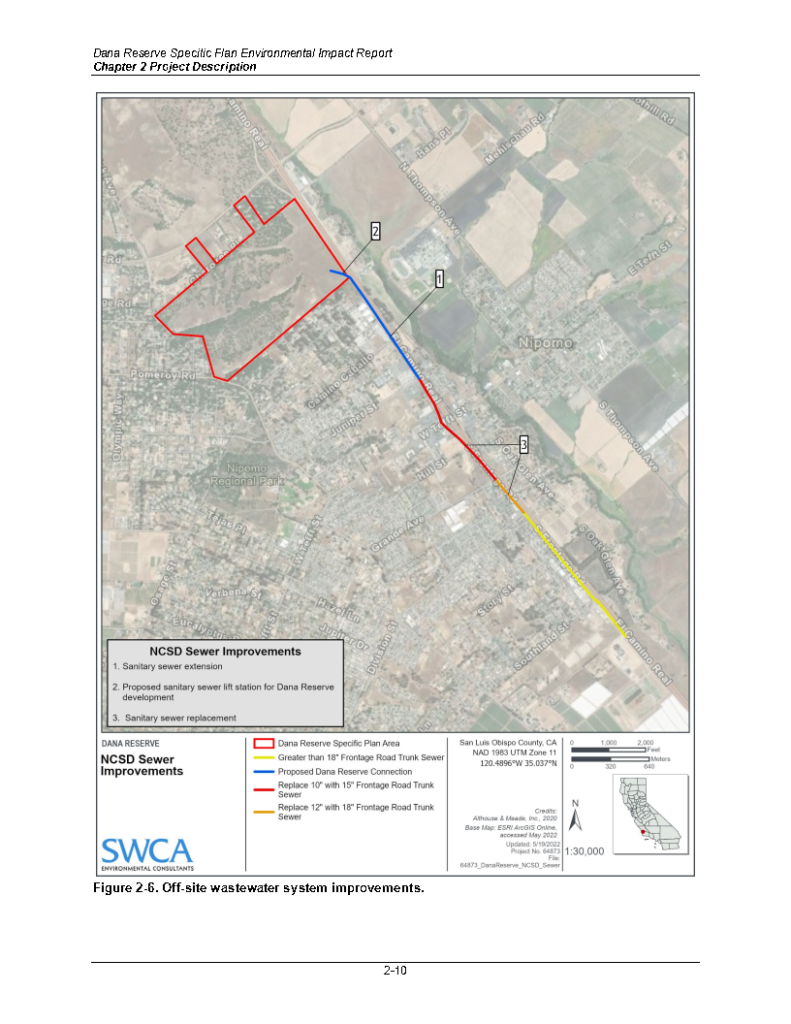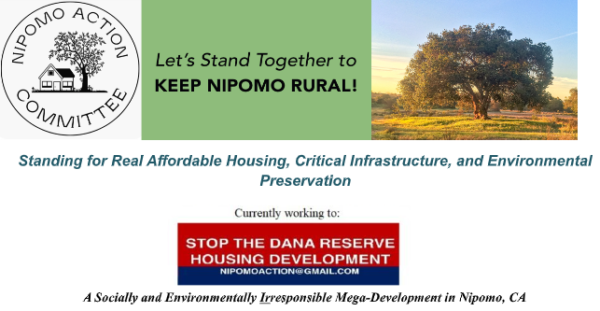Please see this link for the Dana Reserve Rate Final Report:
https://ncsd.ca.gov/wp-content/uploads/2022/07/220517-NCSD-Dana-Reserve-Rate-Final-Report.pdf

General Plan Policy WR 1.9 Discourage new water systems. Enable expansion of public services by community services districts and County service areas to serve contiguous development when water is available. Strongly discourage the formation of new water and sewer systems serving urban development at the fringe and outside of urban or village reserve lines or services lines. Strongly discourage the formation of new mutual or private water companies in groundwater basins with Resource Management System Levels of Severity I, Il, or IlI, except where needed to resolve health and safety concerns.
• This project includes a new water system consuming imported water. As the groundwater condition is at RMS Level of Severity IlI, this would have prevented the developer from making a water import contract that was not channeled through NCSD. Furthermore, imported water would have been better utilized in recharging the groundwater rather than servicing new demand.
General Plan Policy WR 1.13 Density increases in rural areas. Do not approve General Plan amendments or land divisions that increase the density or intensity of non-agricultural uses in rural areas that have a recommended or certified Level of Severity Il or Il for water supply until a Level of Severity I or better is reached unless there is an overriding public need.
• The DEIR notes “The intent of this policy is to encourage infill development and conserve water resources.” As this development is at the northeastern margin of the NCSD service area, it hardly qualifies as infill. NCSD water service to an area north of the proposed development was emplaced as an emergency measure after Nipomo ran out of water.
NCSD has stated that the amount of imported water is sufficient to serve both this project and other potential future projects within the NCSD service area, while not contributing to pumping from Nipomo Mesa sources. The allocation of this imported water to serve future development may severely constrain the use of the water in recovering groundwater levels in the basin.
The Nipomo Mesa Management Reports for 2020 and 2021 reveal a loss of groundwater storage of 8,807 AF in 2021 and 8,582 AF in 2020. This is also demonstrated by the Key Wells Index which shows continuing declines in well levels. In addition, the Reports show that groundwater extraction from the Nipomo Mesa Management Area was 13,677 AF in 2021 and 14,313 AF in 2020. This implies that about half of the extractions were mined from storage at a time when supplemental water was importing in 3,002 AF in 2021 and 3,809 AF in 2020. NCSD notes that supplemental water imports could be as high as 3,000 AFY, which is less than half of the ongoing deficit. This raises the issue that imported water should first be dedicated to recharging the basin beyond the quantities currently being substituted at the well head by water imports.
Wastewater from the project will be treated at the Southland Wastewater Treatment Facility, which is situated at the extreme southeast corner of the Nipomo Mesa, and close to the 130 ft. high bluff bordering the Santa Maria River. Nipomo Mesa Management Reports illustrate groundwater contours showing flow to the southwest, so that it is extremely unlikely that the Southland plant will recharge the production aquifers beneath the Mesa, and more likely returning water to the Santa Maria area.
In its discussion of actual water, the DEIR notes that one of the two sources of water for the proposed project is the Santa Maria River Valley Groundwater Basin. The DEIR states: “Groundwater recharge of the basin occurs from rainfall percolation, riverbed recharge, subsurface inflows, and return flows. The average annual precipitation within the basin is 15.65 inches, based on data collected between 1958 and 2020 (MKN 2021).”
In the Project Setting, the DEIR estimates annual rainfall as between 15 and 20 inches per year. Per the NOWData program of the National Weather Service, mean precipitation in the region since 2000 has been 11.67 inches.
Recent annual precipitation in the area has been as follows:
2018 – 8.63
2019 – 17.10
2020 – 8.28
2021 – 11.20
NWS precipitation levels for the first five months of 2022 are:
Jan.: 0.17
Feb.: 0.07
Mar.: 1.07
Apr.: 0.39
May: 0.00
In 22 years of measurements, the NWS recorded 1 year when precipitation for the project area met or exceeded 20 inches of rain, which was solely due to a record-breaking month in December 2010. Of the records lows set for minimum monthly precipitation over the last 22 years, 9 of the 12 record minimums (0.00) were set in the last 4 years.
This corresponds with California Drought Action’s finding that “2022 had the driest January, February, and March in over 100 years” (http://(https://drought.ca.gov). Per the State of California, the last 3 years have produced “a historic level of dryness…and it’s only getting worse.” This data should be weighed against the DEIR’s statement that average annual precipitation for the area – if the average is calculated using data stretching back six decades — is 15.65 inches. For current precipitation levels, see the National Weather Service data above.
In noting that the region is currently in a Stage 4 drought condition, the DEIR appears to rely on the belief that the “voluntary reduction measures” triggered by Stage 4 and Stage 5 designations will assure available water in any drought condition of any duration. We note the Governor has asked that Californians cut their water use by 15% from 2020 levels, but this has produced not more than a 3.7% reduction.
In conclusion, even though water for the project would be supplied by NCSD using imported water, there are several apparent county policy inconsistencies, and importantly, that the project does not contribute to recovery of local water tables before providing service to more people, which was to only be conducted under health and safety considerations (per general plan policy WR 1.9).
Note the NCSD Groundwater levels from the NMMA annual report for 2021. Link Here: http://ncsd.ca.gov/resources/reports-by-subject/#nmma

Note that Santa Maria does receive a substantial portion of water from the State Water Project:
https://www.ccwa.com/2022-state-water-project-table-a-allocation-decrease-from-15-to-5-percent
What does this info reveal? It shows that State Water Project is only supplying the City of Santa Maria at 5% of its requested allocation (down from 15%). The Supplemental Water Project (City of Santa Maria water supplied to NCSD) is clearly being pumped from the Santa Maria aquifer to Nipomo to minimize pumping from the over drafted Nipomo Mesa aquifer. If the drought continues indefinitely, the Santa Maria basin will also be in an overdraft condition and threaten Nipomo’s water supply. This is a serious situation that needs to be considered in all future large scale construction projects that need hookup to NCSD.
Sewer:
- Sewer Services will be tied into existing service. Existing facilities along South Frontage and through Tefft will be upsized and new sewer connections will be added along both frontage and throughout the project.

